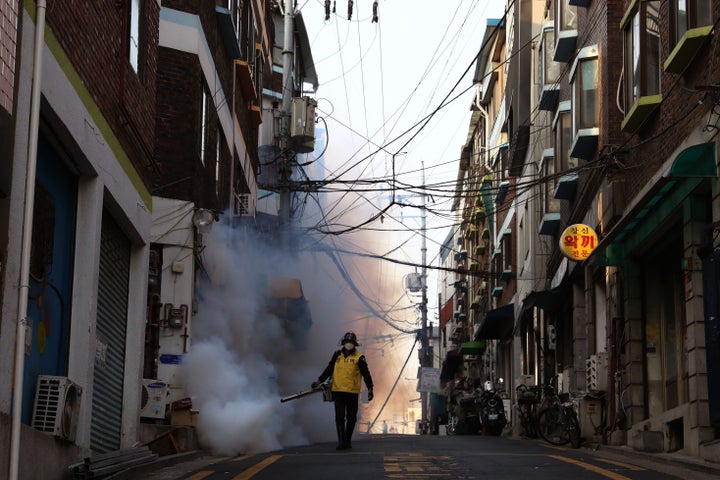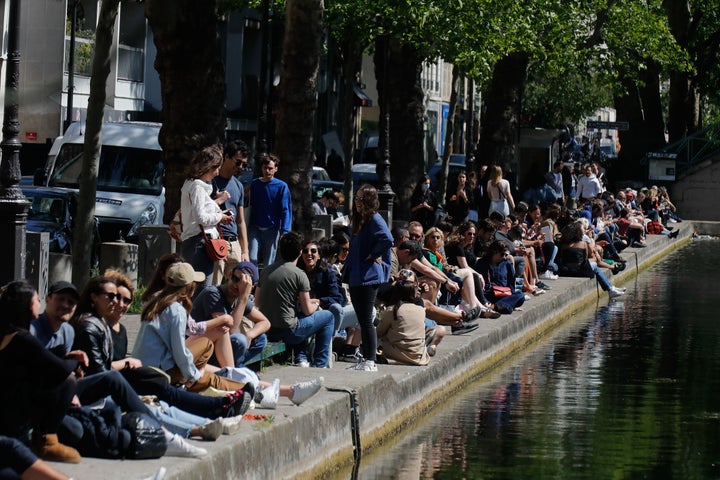After months under strict lockdowns, Europeans have finally begun to enjoy a sense of newfound freedom in recent days — drinking at cafes, visiting museums and spending time outdoors with friends and family.
The slow resumption of daily life represents a milestone in the fight against the coronavirus pandemic. But it also raises concerns about a second wave of infections, scientists warn.
“The fear of a second wave is there, the risk of it coming is high,” epidemiologist Pier Luigi Lopalco told HuffPost Italy.
If infection rates start to tick upward again, recent images of people gathering together at bars and in parks could seem less like a sign of life returning to normal, and more like a harbinger of another deadly catastrophe.
The question of a second wave is “when and how big,” Andrea Ammon, director of the European Centre for Disease Prevention and Control, told The Guardian.
“I don’t want to draw a doomsday picture, but I think we have to be realistic. That it’s not the time now to completely relax.”

The push to relax lockdown restrictions has been driven by a need to balance economic considerations with the risk to public health.
With businesses shuttered and millions of people unable to work, the European Union is facing the “deepest economic recession in its history,” a top official announced this month, meaning any decision to reimpose lockdowns could be contested by employers and difficult to enforce.
Already, however, the easing of restrictions in various parts of the world has led to some worrying developments.
In South Korea, a spike in coronavirus cases connected with a handful of nightclubs in Seoul has prompted health officials to test tens of thousands of people, in order to identify and isolate infected individuals.
China reported a cluster of new cases in Wuhan this month as well, the first since the city’s lockdown was lifted on April 8.
Fears of a second wave have increased in Germany, too, where the coronavirus infection rate has risen slightly.

Brief increases in the number of coronavirus cases, however, aren’t necessarily cause for concern.
“Individual days are not a problem,” Lars Schaade, vice president of Germany’s Robert Koch Institute, said this month, noting that a real danger signal would be a sustained increase in the infection rate over a number of days.
German chancellor Angela Merkel this month announced a new “emergency mechanism” that would allow the government to reimpose local lockdown restrictions if the number of infections exceeded a certain threshold.
“We have to be careful that this thing doesn’t slip from our grasp,” Merkel said.
But the new outbreaks in Europe and Asia highlight how quickly the virus can reemerge after being beaten back. And they reinforce the need for people to remain vigilant and closely follow safety measures, such as hand-washing and social distancing.
“At this stage, more than ever before, even when we are outside, social distancing and the use of masks remains fundamental,” Italy’s prime minister Giuseppe Conte said this week, as the country began reopening bars, cafes, restaurants and shops. “Now is not the time for parties, nightlife and getting together in crowds.”

As HuffPost Italy reports, however, photos and videos shared on social media this week have showed crowds of people ― particularly those in their 20s and 30s ― partying in streets and town squares across the country, often without masks, cocktails in hand.
“This is absolutely not good. It is clear that if this continues, we will be forced to stop those activities,” Attilio Fontana, the governor of Italy’s Lombardy region, said this week.
Local Italian officials are stepping up enforcement efforts. People who flout the current guidelines could be fined up to 3,000 euros (£2,688), HuffPost Italy reports.
“Those who make mistakes will pay,” Sergio Giordani, the mayor of Padua, in northern Italy, said this week.
Padua is promoting a campaign to emphasise that “we only save ourselves together,” Giordani said.
“What is needed is above all a sense of responsibility,” Antonio Decaro, the mayor of the southern Italian city of Bari, told HuffPost Italy.
In France, police have dispersed crowds of Parisians who gathered in the city’s parks, and on the banks of the Canal Saint-Martin and the river Seine to celebrate last week’s easing of the country’s lockdown.
In the United States, Donald Trump and other government officials have been eager for states to reopen, which could help revive the economy and save millions of jobs.
But researchers also worry that lifting lockdown restrictions could cause between 15,000 and 73,000 additional US deaths by the end of July, according to a forecast from the University of Pennsylvania’s Penn Wharton Budget Model. If people fail to adhere to social distancing measures, the death toll could be even higher — rising by as many as 135,000 people by the end of July, the researchers found.
“Everyone wants us to talk about policy, but in fact personal behaviour still matters a lot here,” Kent Smetters, the faculty director at the Penn Wharton Budget Model, told The New York Times.
The possibility of a second wave is “our greatest fear,” virologist Fabrizio Pregliasco, a researcher at the State University of Milan, told HuffPost Italy. “Everything will depend on our behaviour. In this phase, individual responsibility remains fundamental.”
This has been the message in the UK as well, where Boris Johnson has called on the public to use “good, solid, British common sense” in obeying social distancing rules as lockdown restrictions are gradually relaxed.
Yet staving off a second wave of infections will require government action, in addition to a commitment from the public to avoid crowds and continue washing hands.
A robust system of tracking and tracing infected individuals, similar to the one currently in place in South Korea, is seen as crucial to preventing a deadly second wave of the outbreak — and thus getting the economy working again after the lockdown.
Britain’s testing capacity has been slow to ramp up, however, and a new smartphone contact tracing app developed by the NHS won’t be ready for some time.
The NHS Confederation, a group that represents the health service’s organisations, said the country is at risk of a second jump in cases without clarity on government strategy.
“The relaxation of restrictions based on scientific advice is the right approach, but it must be accompanied by an effective test, track and trace strategy which enables us to monitor local spread of the disease,” the confederation said this week.
“To achieve this we must have national, local and cross-agency involvement. Without this, we do face the risk of a second wave of infections.”
In the United States, Anthony Fauci, director of the National Institute of Allergies and Infectious Diseases, similarly warned in Senate testimony last week that reopening too quickly could lead to a second wave.
If states “prematurely open up without having the capability of being able to respond effectively and efficiently, my concern is that we will start to see little spikes that might turn into outbreaks,” Fauci said. “The consequences could be really serious.”

Last week, the World Health Organisation stressed that the coronavirus “may never go away.”
The coming months and years, therefore, will likely see outbreaks cropping up from time to time across the world, as has happened this month in South Korea, China and Germany.
Going forward, the hope is that countries will have established policies and built up the infrastructure that will allow them to identify and contain these outbreaks quickly, without resorting to nationwide lockdowns.
After all, even with strong compliance from the public with regard to social distancing and other safety measures, periodic outbreaks are inevitable.
“Living with the virus,” Pier Luigi Lopalco told HuffPost Italy, “means accepting that some people will get infected.”
With reporting from HuffPost Italy, HuffPost France, HuffPost UK, and Reuters.

